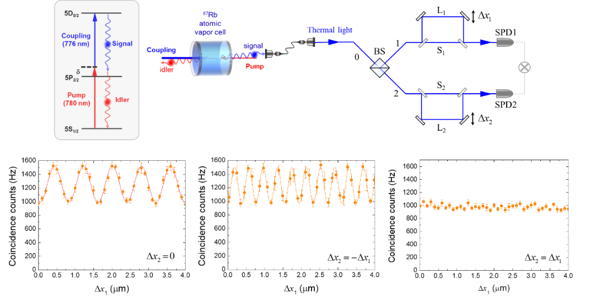The interference phenomenon forms the most important evidence of the wave-like property of light. The phase of the wave is the key concept underlying the interpretation of constructive and destructive interferences of superposed light beams. On the other hand, it is known that even when light is considered as a particle or photon, a single photon can interfere with itself. Although light exhibits both wave- and particle-like properties, the linear superposition of the field amplitudes for light waves is the same as that of the probability amplitudes of a photon in the case of first-order interference.
However, beyond the classical physics perspective, we can consider quantum interference, which refers to multi-photon interference due to the quantum nature of light. The simplest multi-photon interference is two-photon interference, which is a second-order interference phenomenon. In experimental quantum optics, multi-photon interference lies at the heart of quantum optics research and quantum information applications such as quantum communication, quantum simulation, quantum computing, and quantum metrology. In particular, Franson interference beyond the single-photon coherence length in twin nonlocal unbalanced interferometry experiments is considered a counterintuitive phenomenon from the viewpoint of classical physics. The famous Franson interference experiment is important for understanding both the nonlocal nature of entanglement and the characteristics of time–energy entangled photons via coincidence detection according to the phase difference between the two two-photon amplitudes in unbalanced interferometers. Thus far, several Franson interference experiments have been demonstrated with the use of entangled photon pairs, keeping in mind that Franson interference is regarded as evidence of the nonclassical nature of photon sources with time–energy entangled photons.
Recently, the research group led by Prof. H. S. Moon from the Pusan National University of South Korea reported, for the first time to the best of our knowledge, a second-order interference experiment using real thermal light emitted from a warm atomic ensemble and propagated along two spatially separated unbalanced Michelson interferometers (UMIs), which is published in Photonics Research, Vol.9, No.1, 2021(Jiho Park, Heonoh Kim, Han Seb Moon. Second-order interference of true thermal light from a warm atomic ensemble in two independent unbalanced interferometers[J]. Photonics Research, 2021, 9(1): 01000049).

Second-order interference with real thermal light from Doppler-broadened cascade-type 87Rb atoms in Franson-type interferometer
They used superradiantly emitted thermal light from Doppler-broadened cascade-type 87Rb atoms by exploiting collective two-photon coherence. The long coherence time of the thermal light from the atomic ensemble enables the observation that its second-order interference in the two independent UMIs by means of time-resolved coincidence detection.
A most interesting aspect is that the temporal waveforms of the interfering thermal light in the two spatially separated interferometers exhibit similarities with the temporal two-photon waveforms of time–energy entangled photon pairs in Franson interferometry.
Prof. H. S. Moon believes that their study makes a significant contribution to the literature because of its immediate bearing on quantum information science and related fields of application.


